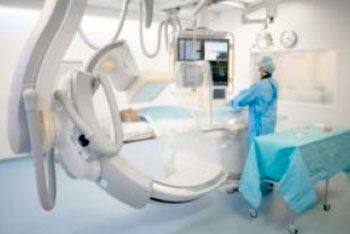Imaging Technology May Slash X-Ray Exposure for Liver Cancer Patients
By MedImaging International staff writers
Posted on 10 Dec 2014
Researchers reported that their evaluation of an interventional X-ray guidance device approved by the US Food and Drug Administration (FDA) in 2013 has the potential to reduce the radiation exposure of patients undergoing intra-arterial therapy (IAT) for liver cancer.Posted on 10 Dec 2014
The study’s findings were presented at the 100th annual meeting of the Radiological Society of North America (RSNA) in Chicago (IL, USA) where John Hopkins University (Baltimore, MD, USA) researchers described the findings of a clinical trial of the imaging system AlluraClarity developed by Philips Healthcare (Best, The Netherlands), on 50 patients with liver cancer. Its use reduced radiation exposure up to 80%, compared with exposure from a standard imaging X-ray platform used in IAT, while producing images just as clear as the standard system, according to Jean-Francois Geschwind, MD, a professor in the Russell H. Morgan department of radiology and radiological science in the Johns Hopkins University School of Medicine and its Kimmel Cancer Center.

Image: The AlluraClarity imaging platform (Photo courtesy of RSNA).
Dr. Geschwind stated that if further studies continue to affirm his team’s findings, the platform may be especially useful for patients who need repeat therapy; children, who are especially vulnerable to radiation; and physicians who routinely use procedures such as IAT and are exposed to radiation.
During IAT, a physician inserts a thin, flexible tube directly into a blood vessel feeding a tumor, using that pathway to deliver chemotherapy or other drugs. X-ray imaging is used during the procedure to visualize the patient’s blood vessels and to guide both the catheter’s placement and drug delivery. Dr. Geschwind and his colleagues compared the radiation exposure of 25 patients with liver cancer treated with IAT using the AlluraClarity platform to the exposure of 25 additional patients with liver cancer treated with IAT using Philips' previous X-ray imaging platform, called Allura.
Dropping the radiation output on standard X-ray imaging platforms can reduce the exposure, but without special image processing, the amount of image noise increases and physicians are unable to see small structures needed for good treatment, according to Ruediger Schernthaner, MD, a postdoctoral research fellow in vascular and interventional radiology at The Johns Hopkins Hospital. “You can compare this to an image taken with your cell phone in the evening without a flash,” he said.
The AlluraClarity platform uses a series of real-time image processing algorithms to achieve high quality images at a lower radiation power, Dr. Schernthaner reported.
Related Links:
John Hopkins University
Philips Healthcare














